

美团面试题:为什么能直接调用userMapper接口的方法?
source link: https://my.oschina.net/u/4728925/blog/4870492
Go to the source link to view the article. You can view the picture content, updated content and better typesetting reading experience. If the link is broken, please click the button below to view the snapshot at that time.

字数:2434,阅读耗时:3分40秒。
老规矩,先上案例代码,这样大家可以更加熟悉是如何使用的,看过Mybatis系列的小伙伴,对这段代码差不多都可以背下来了。
哈哈~,有点夸张吗?不夸张的,就这行代码。
public class MybatisApplication {
public static final String URL = "jdbc:mysql://localhost:3306/mblog";
public static final String USER = "root";
public static final String PASSWORD = "123456";
public static void main(String[] args) {
String resource = "mybatis-config.xml";
InputStream inputStream = null;
SqlSession sqlSession = null;
try {
inputStream = Resources.getResourceAsStream(resource);
SqlSessionFactory sqlSessionFactory = new SqlSessionFactoryBuilder().build(inputStream);
sqlSession = sqlSessionFactory.openSession();
//今天主要这行代码
UserMapper userMapper = sqlSession.getMapper(UserMapper.class);
System.out.println(userMapper.selectById(1));
} catch (Exception e) {
e.printStackTrace();
} finally {
try {
inputStream.close();
} catch (IOException e) {
e.printStackTrace();
}
sqlSession.close();
}
}
看源码有什么用?

通过源码的学习,我们可以收获Mybatis的核心思想和框架设计,另外还可以收获设计模式的应用。
前两篇文章我们已经Mybatis配置文件解析到获取SqlSession,下面我们来分析从SqlSession到userMapper:
UserMapper userMapper = sqlSession.getMapper(UserMapper.class);
前面那篇文章已经知道了这里的sqlSession使用的是默认实现类DefaultSqlSession。所以我们直接进入DefaultSqlSession的getMapper方法。
//DefaultSqlSession中
private final Configuration configuration;
//type=UserMapper.class
@Override
public <T> T getMapper(Class<T> type) {
return configuration.getMapper(type, this);
}
这里有三个问题:

问题1:getMapper返回的是个什么对象?
上面可以看出,getMapper方法调用的是Configuration中的getMapper方法。然后我们进入Configuration中
//Configuration中
protected final MapperRegistry mapperRegistry = new MapperRegistry(this);
////type=UserMapper.class
public <T> T getMapper(Class<T> type, SqlSession sqlSession) {
return mapperRegistry.getMapper(type, sqlSession);
}
这里也没做什么,继续调用MapperRegistry中的getMapper:
//MapperRegistry中
public class MapperRegistry {
//主要是存放配置信息
private final Configuration config;
//MapperProxyFactory 的映射
private final Map<Class<?>, MapperProxyFactory<?>> knownMappers = new HashMap<>();
//获得 Mapper Proxy 对象
//type=UserMapper.class,session为当前会话
public <T> T getMapper(Class<T> type, SqlSession sqlSession) {
//这里是get,那就有add或者put
final MapperProxyFactory<T> mapperProxyFactory = (MapperProxyFactory<T>) knownMappers.get(type);
if (mapperProxyFactory == null) {
throw new BindingException("Type " + type + " is not known to the MapperRegistry.");
}
try {
//创建实例
return mapperProxyFactory.newInstance(sqlSession);
} catch (Exception e) {
throw new BindingException("Error getting mapper instance. Cause: " + e, e);
}
}
//解析配置文件的时候就会调用这个方法,
//type=UserMapper.class
public <T> void addMapper(Class<T> type) {
// 判断 type 必须是接口,也就是说 Mapper 接口。
if (type.isInterface()) {
//已经添加过,则抛出 BindingException 异常
if (hasMapper(type)) {
throw new BindingException("Type " + type + " is already known to the MapperRegistry.");
}
boolean loadCompleted = false;
try {
//添加到 knownMappers 中
knownMappers.put(type, new MapperProxyFactory<>(type));
//创建 MapperAnnotationBuilder 对象,解析 Mapper 的注解配置
MapperAnnotationBuilder parser = new MapperAnnotationBuilder(config, type);
parser.parse();
//标记加载完成
loadCompleted = true;
} finally {
//若加载未完成,从 knownMappers 中移除
if (!loadCompleted) {
knownMappers.remove(type);
}
}
}
}
}
MapperProxyFactory对象里保存了mapper接口的class对象,就是一个普通的类,没有什么逻辑。
在MapperProxyFactory类中使用了两种设计模式:
-
单例模式methodCache(注册式单例模式)。
-
工厂模式getMapper()。
继续看MapperProxyFactory中的newInstance方法。
public class MapperProxyFactory<T> {
private final Class<T> mapperInterface;
private final Map<Method, MapperMethod> methodCache = new ConcurrentHashMap<>();
public MapperProxyFactory(Class<T> mapperInterface) {
this.mapperInterface = mapperInterface;
}
public T newInstance(SqlSession sqlSession) {
//创建MapperProxy对象
final MapperProxy<T> mapperProxy = new MapperProxy<>(sqlSession, mapperInterface, methodCache);
return newInstance(mapperProxy);
}
//最终以JDK动态代理创建对象并返回
protected T newInstance(MapperProxy<T> mapperProxy) {
return (T) Proxy.newProxyInstance(mapperInterface.getClassLoader(), new Class[] { mapperInterface }, mapperProxy);
}
}
从代码中可以看出,依然是稳稳的基于 JDK Proxy 实现的,而 InvocationHandler 参数是 MapperProxy 对象。
//UserMapper 的类加载器
//接口是UserMapper
//h是mapperProxy对象
public static Object newProxyInstance(ClassLoader loader,
Class<?>[] interfaces,
InvocationHandler h){
}
问题2:为什么就可以调用他的方法?
上面调用newInstance方法时候创建了MapperProxy对象,并且是当做newProxyInstance的第三个参数,所以MapperProxy类肯定实现了InvocationHandler。
进入MapperProxy类中:
//果然实现了InvocationHandler接口
public class MapperProxy<T> implements InvocationHandler, Serializable {
private static final long serialVersionUID = -6424540398559729838L;
private final SqlSession sqlSession;
private final Class<T> mapperInterface;
private final Map<Method, MapperMethod> methodCache;
public MapperProxy(SqlSession sqlSession, Class<T> mapperInterface, Map<Method, MapperMethod> methodCache) {
this.sqlSession = sqlSession;
this.mapperInterface = mapperInterface;
this.methodCache = methodCache;
}
//调用userMapper.selectById()实质上是调用这个invoke方法
@Override
public Object invoke(Object proxy, Method method, Object[] args) throws Throwable {
try {
//如果是Object的方法toString()、hashCode()等方法
if (Object.class.equals(method.getDeclaringClass())) {
return method.invoke(this, args);
} else if (method.isDefault()) {
//JDK8以后的接口默认实现方法
return invokeDefaultMethod(proxy, method, args);
}
} catch (Throwable t) {
throw ExceptionUtil.unwrapThrowable(t);
}
//创建MapperMethod对象
final MapperMethod mapperMethod = cachedMapperMethod(method);
//下一篇再聊
return mapperMethod.execute(sqlSession, args);
}
}
也就是说,getMapper方法返回的是一个JDK动态代理对象(类型是$Proxy+数字)。这个代理对象会继承Proxy类,实现被代理的接口UserMpper,里面持有了一个MapperProxy类型的触发管理类。
当我们调用UserMpper的方法时候,实质上调用的是MapperProxy的invoke方法。
userMapper=$Proxy6@2355。
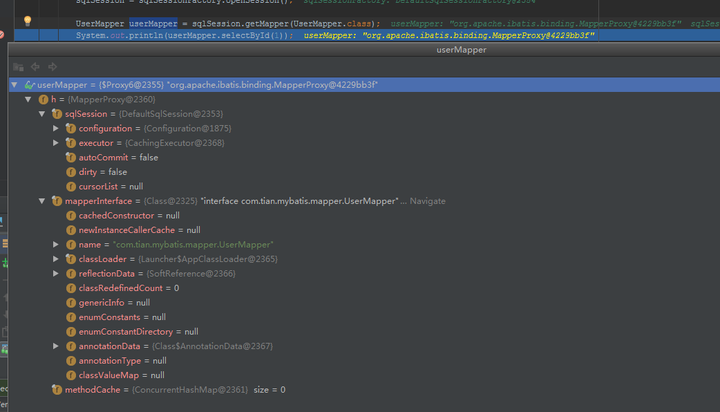
为什么要在MapperRegistry中保存一个工厂类?
原来他是用来创建并返回代理类的。这里是代理模式的一个非常经典的应用。
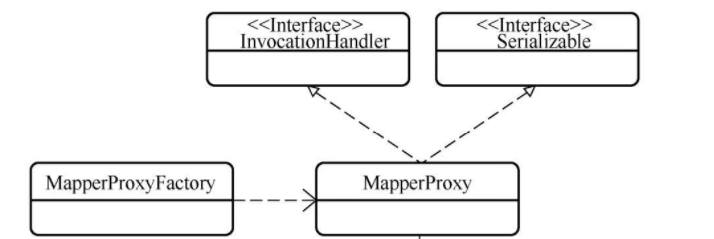
MapperProxy如何实现对接口的代理?
JDK动态代理
我们知道,JDK动态代理有三个核心角色:
-
被代理类(即就是实现类)
-
实现了InvocationHanndler的触发管理类,用来生成代理对象。
被代理类必须实现接口,因为要通过接口获取方法,而且代理类也要实现这个接口。
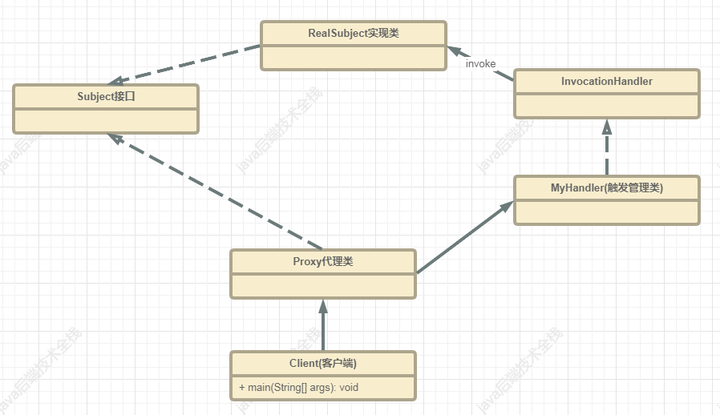
而Mybatis中并没有Mapper接口的实现类,怎么被代理呢?它忽略了实现类,直接对Mapper接口进行代理。
MyBatis动态代理:
在Mybatis中,JDK动态代理为什么不需要实现类呢?
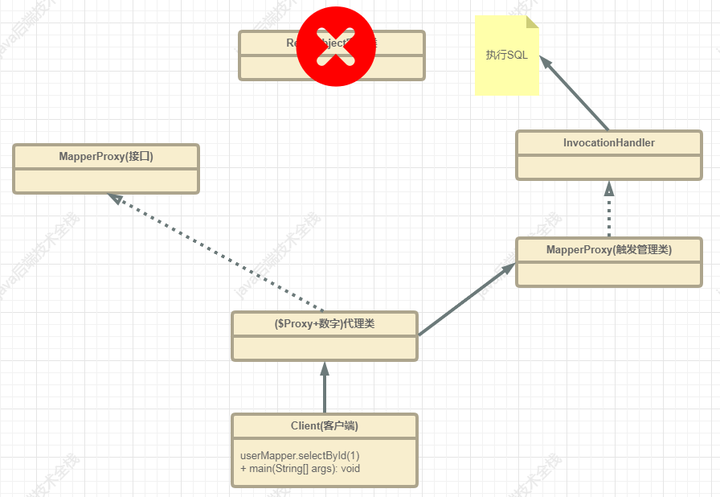
这里我们的目的其实就是根据一个可以执行的方法,直接找到Mapper.xml中statement ID ,方便调用。
最后返回的userMapper就是MapperProxyFactory的创建的代理对象,然后这个对象中包含了MapperProxy对象,
问题3:到底是怎么根据Mapper.java找到Mapper.xml的?
最后我们调用userMapper.selectUserById(),本质上调用的是MapperProxy的invoke()方法。
请看下面这张图:
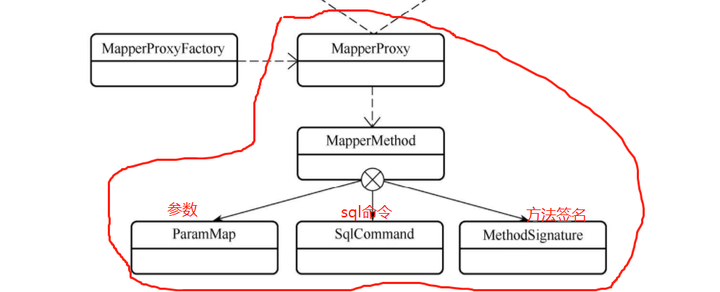
如果根据(接口+方法名找到Statement ID ),这个逻辑在InvocationHandler子类(MapperProxy类)中就可以完成了,其实也就没有必要在用实现类了。

本文中主要是讲getMapper方法,该方法实质上是获取一个JDK动态代理对象(类型是Proxy+数字),这个代理类会继承MapperProxy类,实现被代理的接口UserMapper,并且里面持有一个MapperProxy类型的触发管理类。这里我们就拿到代理类了,后面我们就可以使用这个代理对象进行方法调用。
问题涉及到的设计模式:
-
代理模式。
-
工厂模式。
-
单例模式。
整个流程图:
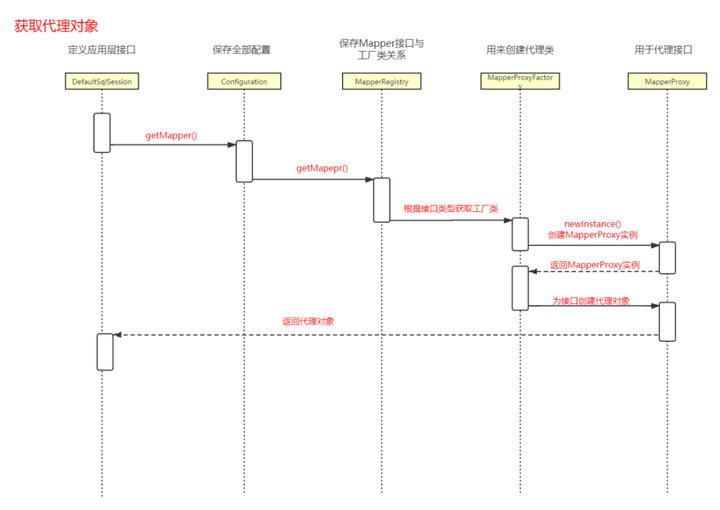
冰冻三尺,非一日之寒表面意义是冰冻了三尺,并不是一天的寒冷所能达到的效果。学习亦如此,你每一天的一点点努力,都是为你以后的成功做铺垫。
Recommend
About Joyk
Aggregate valuable and interesting links.
Joyk means Joy of geeK